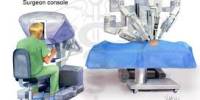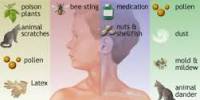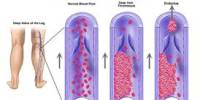Down Syndrome (Symptoms, Diagnosis, and Treatment)
Definition: Down syndrome (DS or DNS), also known as trisomy 21, is a genetic condition that results when there is an extra copy of a specific chromosome, chromosome 21. It is not an illness but a term that describes the features resulting from this change. It is typically associated with physical growth delays, mild to moderate intellectual disability, and characteristic facial features. The average IQ of a young adult with Down syndrome is 50, equivalent to the mental ability of an 8 or 9-year-old child, but this can vary widely.
The parents of the affected individual are typically genetically normal. The probability increases from less than 0.1% in 20-year-old mothers to 3% in those age 45. Down syndrome can be identified during pregnancy by prenatal screening followed by diagnostic testing or after birth by direct observation and genetic testing. Since the introduction of screening, pregnancies with the diagnosis are often terminated. Regular screening for health problems common in Down syndrome is recommended throughout the person’s life.
Down syndrome varies in severity among individuals, causing lifelong intellectual disability and developmental delays. It’s the most common genetic chromosomal disorder and cause of learning disabilities in children. It also commonly causes other medical abnormalities, including heart and gastrointestinal disorders.
There are three types of Down syndrome: Trisomy 21, Mosaicism, and Translocation.
Down syndrome is one of the most common chromosome abnormalities in humans. It occurs in about one per 1,000 babies born each year. It is named after John Langdon Down, a British doctor who fully described the syndrome in 1866. Some aspects of the condition were described earlier by Jean-Étienne Dominique Esquirol in 1838 and Édouard Séguin in 1844. In 1959, the genetic cause of Down syndrome, an extra copy of chromosome 21, was discovered.
However, people with Down syndrome can live healthy and fulfilling lives. Recent medical advances, as well as cultural and institutional support for people with Down syndrome and their families, provides many opportunities to help overcome the challenges of this condition.
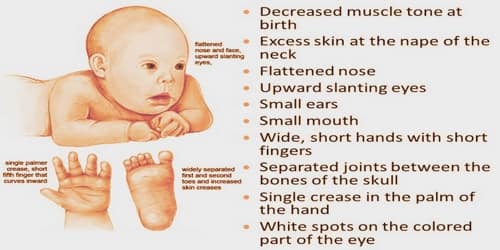
Signs and Symptoms of Down syndrome: Those with Down syndrome nearly always have physical and intellectual disabilities. As adults, their mental abilities are typically similar to those of an 8- or 9-year-old. Some people are healthy while others have significant health problems such as serious heart defects.
Children and adults with Down syndrome have distinct facial features. Though not all people with Down syndrome have the same features, some of the more common features include:
- Flattened face
- Small head
- Short neck
- Protruding tongue
- Upward slanting eyelids (palpebral fissures)
- Unusually shaped or small ears
- Poor muscle tone
- Broad, short hands with a single crease in the palm
- Relatively short fingers and small hands and feet
- Excessive flexibility
- Tiny white spots on the colored part (iris) of the eye called Brushfield’s spots
- Short height
An infant with Down syndrome can be born an average size but will develop more slowly than a child without the condition. People with Down syndrome usually have some degree of developmental disability, but it’s often mild to moderate. Mental and social development delays may mean that the child could have:
- impulsive behavior
- poor judgment
- short attention span
- slow learning capabilities
Growth in height is slower, resulting in adults who tend to have short stature—the average height for men is 154 cm (5 ft 1 in) and for women is 142 cm (4 ft 8 in). Individuals with Down syndrome are at increased risk for obesity as they age. Growth charts have been developed specifically for children with Down syndrome.
Males with Down syndrome usually do not father children, while females have lower rates of fertility relative to those who are unaffected. Fertility is estimated to be present in 30–50% of females. Menopause typically occurs at an earlier age. The poor fertility in males is thought to be due to problems with sperm development; however, it may also be related to not being sexually active
Children with Down syndrome usually are diagnosed before or at birth. However, if people have any questions regarding their pregnancy or their child’s growth and development, talk with their doctor.
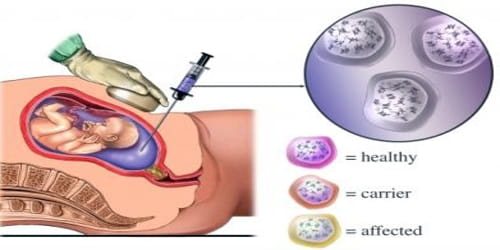
Diagnosis and Treatment of Down syndrome: Women with a higher chance of having a child with Down syndrome may receive screening and diagnostic tests. Women aged 30 to 35 years or older may receive genetic screening during pregnancy because of the risk of having a child with Down syndrome increases as women age.
Screening is a cost-effective and less invasive way to determine if more invasive diagnostic tests are needed. However, unlike diagnostic tests, they cannot confirm whether Down syndrome is present.
Screening tests can estimate the probability of Down syndrome being present. Some diagnostic tests can definitively tell whether the fetus has the condition.
The doctor may order additional tests to detect Down syndrome in your baby. These may include: Amniocentesis, Chorionic villus sampling (CVS), Percutaneous umbilical blood sampling (PUBS, or cordocentesis).
At birth, the doctor will:
- perform a physical examination of the baby
- order a blood test called a karyotype to confirm Down syndrome
The extra genetic material present in DS results in overexpression of a portion of the 310 genes located on chromosome 21. This overexpression has been estimated at around 50%. Some research has suggested the Down syndrome critical region is located at bands 21q22.1–q22.3, with this area including genes for amyloid, superoxide dismutase, and likely the ETS2 proto-oncogene. Other research, however, has not confirmed these findings. microRNAs are also proposed to be involved.
There’s no cure for Down syndrome, but there’s a wide variety of support and educational programs that can help both people with the condition and their families. However, additional health screening for common problems may be recommended.
Early intervention can help the individual maximize their potential and prepare them to take an active role in the community.
School is an important part of the life of a child with Down syndrome, regardless of intellectual ability. Public and private schools support people with Down syndrome and their families with integrated classrooms and special educational opportunities. Schooling allows valuable socialization and helps students with Down syndrome to build important life skills.
Information Source:

